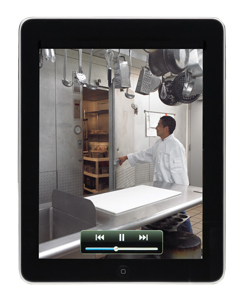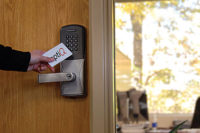
|
|
ABOVE: Because smartphones have become increasingly vital tools for business owners, remote and mobile video capabilities have become just as important for their business operations, as they have for security functions. PHOTO COURTESY OF HONEYWELL |
If you have a smartphone, congratulations. You’re now in the majority.
So says a Nielsen survey conducted in March, which found that 50.4 percent of U.S. mobile subscribers owned a smartphone.
This shouldn’t really be surprising. Case in point: “There’s an app for that” has become part of our lexicon. Mobile is more than here to stay; it’s driving a large part of our lives from the way we watch TV to the way we connect with each other to the way we do business. (View the chart "Mobile Video Apps & Their Features" for a breakdown of companies and available apps.)
To gauge the direction in which the security industry is most likely heading, one needs look no farther than QuickPlay Media’s 2012 U.S. Mobile TV and Video Survey. The company, which provides managed solutions for distributing video to IP-connected devices, polled 526 U.S.-based mobile phone subscribers between the ages of 18 and 44 about their mobile video viewing habits. The majority of respondents — 57 percent — indicated some level of interest in multi-screen viewing, such as watching video on a number of devices. Phones are the preferred means of watching mobile video for 63 percent of respondents, and tablets are the device of choice for 33 percent of respondents.
Granted, these results are completely focused on TV viewing, but the results have a lot to say about where the security industry is going. After all, trends in the consumer space have tended to shape the direction of the security industry, and mobile video should prove no exception.
For a security-specific perspective, look at SDM’s recent online poll, which asked, “How important are mobile devices, generally, to your customers’ security operations?” Of the 427 respondents, 67 percent answered “very important.”
It is natural that the majority of DVR and NVR manufacturers would supply some sort of smartphone application for accessing live and/or recorded video.
Peace of Mind
Strip away their high-tech trappings, and the popularity of — and demand for — mobile and remote video viewing comes down to the same basic reason people have wanted security systems from the very beginning: peace of mind. The only difference today is that that peace of mind is at end users’ fingertips, no matter where they may be.
The ability to check in on a home or business from a computer when you’re not there goes a long way towards providing that peace of mind. The ability to do that while you’re, say, sitting on a train or standing in line at the bank makes that peace of mind much, much more solid. And that, says Keith Maley, president of Harrisburg, Pa.-based Knight Security Systems, is why there’s been an explosion in the number of manufacturers and others who offer smartphone apps specifically for viewing video systems.
“People like to look in and make sure everything’s okay, even in larger commercial applications,” he says. “Mobile has really changed the position of a security system. It’s now something you can touch, something you can reach out to, wherever you’re at, as long as you have a cell phone and Internet service.”
Changing the Sales Process
In some ways, this explosion in demand for and popularity of mobile and remote video viewing has caused installers and integrators like Knight Security and American Video and Security to change the way they position security systems to their customers.
For starters, what was once more of a value-add, or simply a “check out this cool feature” toss-in during the sales process, has become a primary focus, Maley says.
“Mobile is one of the primary things we do,” he says. “When we do a sales call, one of the things we’re casing out in addition to their security needs is what kind of phone they have. We’re quick to whip out our own phones to show to the customer, and they love it.”
Would it be fair to say that mobile is a game-changer? You’d better believe it, Maley adds.
“We’re not talking so much about door contacts and motion detectors; it’s more about how they can view their video from anywhere with their phone.”
As long as the company has been in business, American Video and Security, located in Las Vegas, has included remote viewing software, which can be easily installed on a computer or laptop, with all DVRs it has sold. However, the company’s owner and president, Larry Folsom, wanted to do more, so he formed a separate company called I-View Now, which offers real-time mobile alerts, remote viewing and cloud-based video storage.
While primarily designed to lower the barrier for central stations to offer video verification, it is also a useful tool for customers, who can access live and stored video through an end user Web portal. They also can set alerts that will trigger an email or a text message to their phones. The ability to provide this instant service harnesses the full potential of mobile, Folsom believes.
“Traditionally, when an end user’s alarm goes off, it’s probably 2 in the morning and we say, ‘The alarm went off in zone five,’” he says. “At that point, they really only have a few options: they can ignore it, they can send a guard down or they can go down themselves. Mobile and remote viewing change the paradigm completely.”
Of course, there’s nothing quite like a hands-on demonstration of what a mobile or remote application can do to get a customer’s attention.
“It’s really become an interactive sale. The end user gets to see what it looks like when an alarm goes off. Arming and disarming? We’re all doing that with our security systems, but what are we supposed to do when the alarm goes off? How do we know what caused it?” he says. “So we think our job is to bring this level of video to the end user for the live view from anywhere, as well as for verification.”
Because DVRs and NVRs already offer the ability to view live or recorded video, Maley says adding mobile on top of that is simply a bonus.
“It’s not something we’re upselling; it comes standard,” Maley says. “Even if someone has just an old flip phone, they still have the ability to view video remotely from a computer. And when they get a new phone, they can start using it immediately.”
Smartphones have become a major tool for business owners in general, particularly small business owners. The ability to make phone calls, receive emails, jot down a quick note, quickly take a high-resolution photo and much more have made them an indispensable tool for these business owners to have right in their pocket. That’s why mobile and remote video viewing are so crucial to those same business owners, Folsom says.
“Small business owners are using them in real time to run their businesses,” he says. “This is about putting the data in the end user’s hand in a timely manner so they can actually do something about it. That’s clearly becoming more important.”
Maley says mobile and remote are more definitely more popular with commercial customers, the overwhelming majority of whom want that functionality with their systems. “We’re doing a little more with commercial customers. Ninety percent of the time, those commercial customers want it,” he says. “With most systems, we do remote video. Every once in a while we have a customer who doesn’t need it — like a police station, where they can pull their own video from their DVR or NVR — but most commercial businesses want that ability.”
Compared with the early days of remote video, today’s remote viewing applications are a piece of cake. So while end user comfort with and expectation for remote and mobile applications have been a major driver towards their use for security video, none of that would have been possible without major advances and improvements in the technology behind-the-scenes.
These advances, Maley explains, are what paved the way for this new world in which we now live. “Not that long ago, remote viewing was a huge deal. You had to have a static IP address, a dedicated computer and software on that computer. The static IP address alone could cost as much as $200, but now it’s just there,” Maley says. “Now it’s Internet- or DMBS server-based. That’s where the market really changed.”









